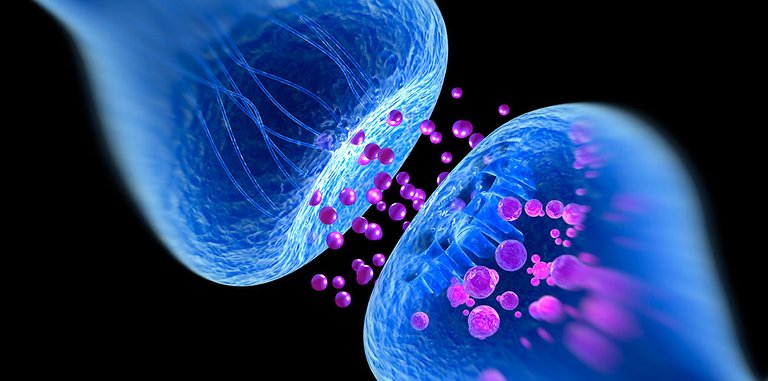What are Synapses?
Synapses are means by which neurons interact or communicate or "talk" to each other or their target organs like muscles or organs like the small intestine, etc.
The neurons and their "targets" can have a small gap in between them or they can be physically connected. If there is a small gap, the synapse is called chemical synapse. If they are touching each other, we call it an electrical synapse.
Chemical synapses are much, much, much more abundant in our bodies compared to electrical synapses.
Our body, especially our brain, have millions of synapses. Each neuron can communicate with thousands of different target cells via many, many synapses and each neuron can receive inputs via thousands of synapses. The incoming information to neurons are usually relayed via synapse at the dendrites and a smaller number of synapses on their cell body as well. Ocassionally impulses can also come in via synapses at the axon terminals. Axon terminals are the ending branches of an axon. Axon terminals are the part that forms part of the synapse with the target organ or another neuron as a matter of fact. We'll just call it "target" from here on to keep things short!!
Now let's look at the structure of a typical chemical synapse.

The membrane of the axon terminal of the neuron bringing the impulse is called the pre-synaptic membrane. The membrane of the target is called the post-synaptic membrane. The very small gap between the pre and post synaptic membranes is called the synaptic cleft.
In the axon terminal, we have some small vesicles called synaptic vesicles. These tiny vesicles contain substances called neurotransmitter. These neurotransmitters are going to be released into the synaptic cleft once the action potential reaches the axon terminal.
On the post synaptic membrane there arereceptors specific for the neurotransmitters that might be released into the synaptic cleft. Once the neurotransmitter binds to the receptors, changes will happen in the target and we can say the information has been transmitted. Now do you remember what is going to happen if the target is another neuron?
Yes. These receptors are going to be ligand gated ion channels and will cause membrane potential changes.
How are neurotransmitters released from their vesicles into the synapse?
Once action potential reaches the axon terminal, the membrane potential changes at that portion will cause opening of voltage gated calcium channels. Ca2+ ion are going to flow into the cell now. Upon entering the pre-synaptic terminal, calcium ions are going to activate synaptogamins.
According to a research published in NCBI journal (link will be in resources) :
Synaptotagmins bind Ca2+ via two C2-domains, and transduce the Ca2+ signal into a nanomechanical activation of the membrane fusion machinery; this activation is mediated by the Ca2+-dependent interaction of the synaptotagmin C2-domains with phospholipids and SNARE proteins.
Once the fusion machinery is activated via the influx of calcium ions, the synaptic vesicles are going to fuse with the pre synaptic membranse and the neurotransmitters are going to be released into the synapse.
Exactly how much neurotransmitter will be released into the synapse and for how long the neurotransmitters will bind to their receptors depends on the frequency or arrival of the action potentials and the duration over which the action potentials are arriving, which in turn controls the amount of calcium ions that can enter the presynaptic terminal. The more the influx of calcium ions, the more neurotransmitters will be released and vice versa. The longer the action potentials keep coming, the longer the neurotransmitters will stay in the synapse and bind to their receptors.
Once the action potential stops coming, the membrane potentials will quickly revert back to it's resting potential and the voltage gated Ca2+ channels will now close. Ca2+ ions will stop flowing into the axon terminal and the normal mechanisms will quickly decrease the levels of calcium inside the cell by throwing them out. The decrease in the level of ca2+ ion will now stop the vesicles from fusing with the membrane. And, so release of neurotransmitter will be stopped.
Sources :
https://www.ncbi.nlm.nih.gov/pmc/articles/PMC3249630/
https://www.khanacademy.org/test-prep/nclex-rn/nervous-system-phy/rn-neuronal-synapses/v/synapse-structure
https://www.khanacademy.org/test-prep/nclex-rn/nervous-system-phy/rn-neuronal-synapses/v/neurotransmitter-release

If you enjoy medical topics, or health tips, please make sure to follow me at @simplifylife
Peace!!

Nice work! I was planning to write a post about toxins affecting neurtransmission... now I can spare myself a good part of explanation and directly link to you. upvoted/followed.
That's great!! I'll be honored if you link my article to your post!! I'll be keeping an eye on your blog for the article on toxins and neurotransmitters!!
Cheers!!
This post has received a 0.05 % upvote from @drotto thanks to: @steemstem-bot.
I have to say I appreciate your style. It's so refreshing to read a topic that is close to my research explained in a such relax and easygoing, yet still eloquent way. Good luck with your studies and keep up the good work - you'll have my upvote every time :)
Thank you very much for your kind words!! May I ask, what is your research topic?
Cheers!!
Hey, sure, I am currently working as a cognitive linguist and I've got my PhD in cognitive-neuroscience :)
That's an incredibly intriguing field!! I hope will get to read more on this on your blog soon xD xD
Jeezuz... i'm just baffled, great job @simplifylife
Thanks so much!!
Well done! This post has received a 10.00 % upvote from @litasio thanks to: @steemstem-bot. Whoop!
10SPIf you would like to delegate to the @LitasIO you can do so by clicking on the following link: